Recumbent: Reclining but not resting

Along Kirra Point, a shelter shed hugs the headland. It’s been there for years and forms part of the Coolangatta heritage walk. The day was sparkling with sunshine in a sky, blue and broad. I’d stopped at the shelter shed – with its high pitched roof, timber slatted gable and verandah railings painted in the familiar Federation colours of yellowy cream, burgundy and white – to take some photos.
I was just about to leave when a man looked into the shelter from the adjoining footpath and asked if I was touring. My Vivente is a touring bike so it’s a question I’m often asked. And that’s how I met Barry, learned about his bike and a week later went for a long chat and a short ride.
You see Barry’s is no ordinary bike. It’s a trike. More accurately a recumbent trike, with an electric motor.
Recumbents situate the rider quite differently to a conventional bicycle. Instead of an upright position where riders push their legs up and down, recumbents seat the rider in a reclining position with the rider’s legs extending in front. This means the recumbent rider is usually much closer to the ground and if you’ve seen one, they typically have a fine flagpole flying a small orange flag to make sure they’re seen.
I’ve only seen a few recumbents and each time, I’ve wondered at their safety, given the lower seating position and the need to rely on mirrors for rear vision. However, seeing my touring bike parked next to Barry’s recumbent trike, I can clearly see the trike would have a bigger presence on the road.
The stability of the tricycle is the feature that sold Barry on this type of cycling. Barry began sailing in his late forties and after 10 years of being on the water, he decided to pull in the sails. While travelling in a campervan around Tasmania, he met a Dutchman who was bicycle touring, had travelled all around Australia by bike and was 66 years old.
This sparked Barry’s interest. As a sailor, he liked the challenge, the navigation and the adventure. Meeting the Dutchman, he realised bike touring had all those things. So, seven years ago at age 58, he bought a touring bike and went cycling – to Japan, North Queensland, Central Australia, Victoria, and to Tibet for a charity fundraiser. He found joys in riding his bicycle akin to sailing. One of them is peacefulness. I asked him to explain this:
“You know when you’re riding downhill and the wind is rushing past your head, it’s noisy. But when you reach the bottom of the hill, there’s silence… it’s peaceful.”
Unfortunately, Barry had a fall on some rough terrain in North Queensland and broke his hip. He returned to cycling but the appeal of the stable recumbent trike was obvious. Touring on the trike feels safer.
It means a slower trip at about 12-14km/hr with a touring load (previously he travelled 15-20km/hr depending on the terrain). But now, with a recently installed electric motor, Barry’s trike will move him along at 25km/hr with very little effort. (Check out the short video at the end of this story to see the acceleration.) He says it’ll help him outride any chasing dogs too!
A recumbent bike might mean reclining but it certainly doesn’t mean resting. Barry said people used to ask him if he was scared when at sea and now they ask him the same about cycling. To him, being fearful doesn’t bring you a good life. In his words:
Fear stops you doing things. You have to take some risk.
Here’s a short video (56 secs) showing Barry’s recumbent trike in action.
Barry demonstrates how the electric assist allows him to stop pedalling and keep moving along. When he changes the setting, watch how the trike takes off! It’s amazing!
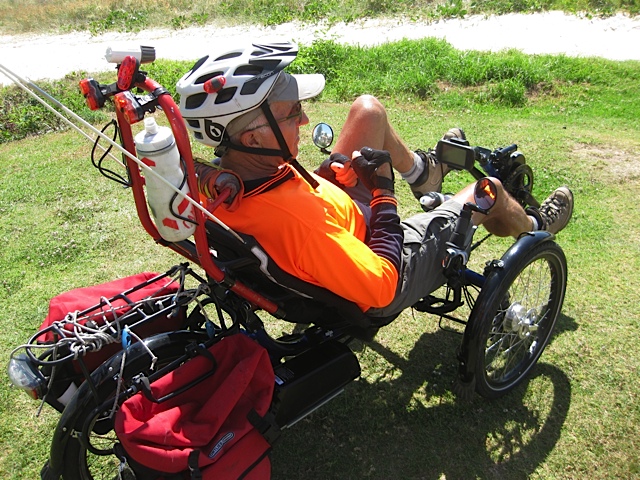
Red panniers at the back for touring. Red tail lights to draw attention and Barry also wears a high-vis shirt.
Tech spec: Barry’s Recumbent Tricycle is made by ICE: Inspired Cycle Engineering.

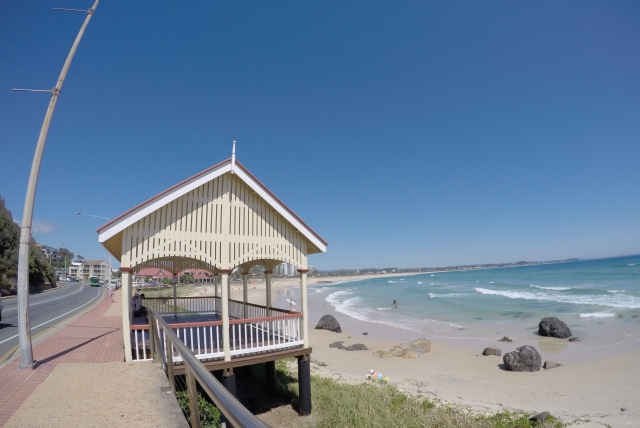
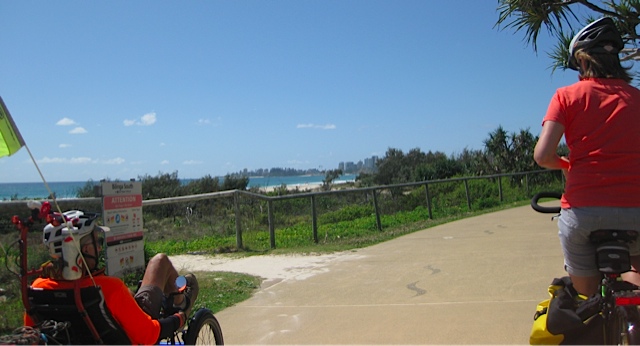
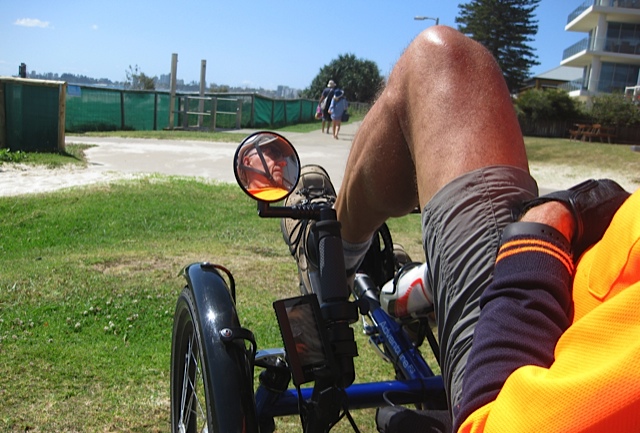
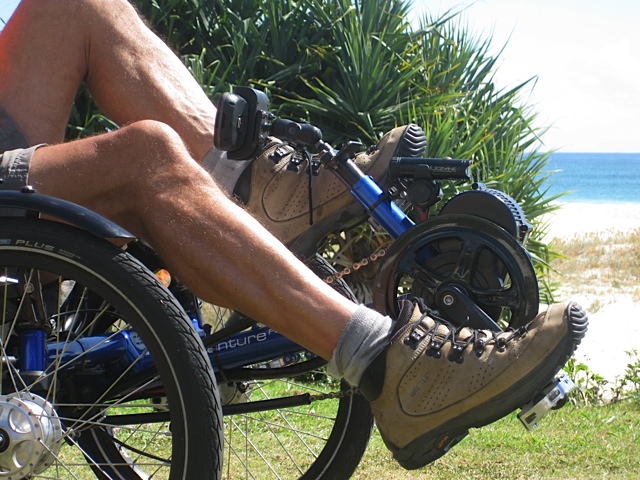
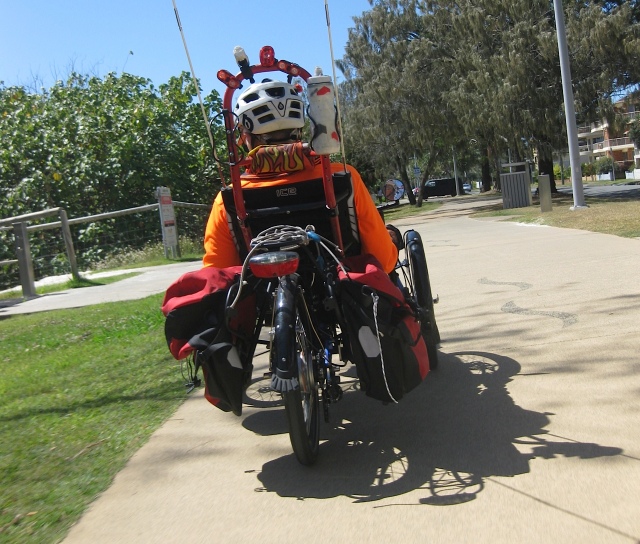
This is an interesting post Gail. I have never tried a recumbent. I have been tempted. There is a store in my neighbourhood (Cambie Cycles – http://www.cambiecycles.com) that actually designs and manufactures them as well as reselling other makes. In fact, the fellow that owns the shop has the locker next to mine at the club. We often talk about the pros and cons but, for whatever reason, they do not seem like a real bike to me. I am concerned that are too low to be seen in traffic, and I don’t feel I would be in the most powerful position to do any distance. Maybe I need to give it a try 🙂
LikeLiked by 1 person
I’m yet to try a recumbent bike too Gary. The seating position seems so foreign when we’re used to riding an upright bike. Another reader of this blog post told me of a work colleague who rides a recumbent AND who is also a sailor. She noted the seating position is similar to that when sailing a small boat – reclining with legs outstretched and close to the water – and wondered if that contributed to a greater sense of ease with riding close to the ground. I wonder how many other happy recumbent bike/trike riders might also be sailors…
LikeLiked by 1 person
That’s an interesting thought. I’ll ask my locker mate when I see him next.
LikeLiked by 1 person
I always think that recumbents look a bit unsafe to ride on the road. It’s dangerous enough in town on a “normal” bike.
LikeLiked by 1 person
This is how I’ve felt about the recumbents too. Now I wonder if the size of the trike might make it stand out more…
LikeLike
Yes. It looks more stable and stands out more than some I’ve seen.
LikeLike
I think it also depends on the type of road you’re riding on – how much passing room there is, what the speed limit is, inner city streets or rural roads. The recumbent would probably suit some places better than others.
I heard from another recumbent rider today that there’s a risk of stones being flicked up because of the low seating position and she’s looking for a helmet with a face shield.
LikeLike
Barry’s a rockstar! I appreciate his comments on fear. That is the way I view fear and risk as well, but sometimes I wonder if I am just being young, naïve and reckless. It is good to hear these sentiments from someone who has more experience than I do.
Thanks for sharing his story, Gail!
LikeLiked by 1 person
Barry’s thoughts about fear and risk struck a chord with me too, Bri 😀
It’s never possible to eliminate all risk and I think, if we try to, then life becomes far too restrictive and driven by fear. Allowing for some risk opens the door for fun and freedom to enter.
And your bicycle journey shows that clearly. I really enjoyed reading about your attitude towards your second winter of riding through the snow – very refreshing!
LikeLike
Yeah, biking last winter was a breakthrough for me-mentally, spiritually and physically-it changed my outlook on life 🙂
LikeLiked by 1 person
Looks like a sweet ride.
LikeLiked by 1 person
It was fun. I couldn’t believe how Barry’s trike took off with the electric motor on full speed. I had to pedal my hardest to catch up! 😀
LikeLiked by 1 person
Gail, the people you meet! HaHa. Barry, what a character. And I loved the video.
I’ve always thought those things were dangerous and a lot of hard work.
And the Kirra Beach shelter shed. Every time I pass by that shelter the memories of family holidays in the 60’s spent at North Kirra come flooding back. Sun, sand and the simple life.
LikeLiked by 1 person
I’m so glad Barry said hello. It was really interesting to learn about his recumbent and his story. We had a good yarn.
The old shelter shed is beautiful. Kirra would’ve been very different back in the 60s – fewer buildings, fewer cars, fewer man-made rock walls probably too. I love the imagery of the sun, sand and simple life… sounds great!
LikeLiked by 1 person
I’ve got a photo of the shelter shed somewhere. I’ll try and find it.
LikeLiked by 1 person
Please do Gina. That’d be good to see.
LikeLike
Hi Gail,
I’ve always been curious about recumbents so thank you introducing Barry and his trike. I think recumbents can be a good option for people who have upper body problems. Also, I have seen a fellow in Brisbane who has a recumbent he pedals with his arms as he has no legs. I feel a little nervous about the thought of being lower to the ground but I’ve noticed that cars seem to be kinder/more patient with recumbent riders. Maybe they may assume the rider has a disability and are less aggressive to them? Hmm…maybe I’ll give one a go! 😉
LikeLiked by 1 person
🙂 Hi Jane, they’re certainly an interesting style of riding. I agree, they’re also quite versatile in that they might suit people with different abilities – that’s a good point!
It seems the lower seating position is the aspect that might be ‘an acquired taste’, so to speak. Be sure to let me know if you do give one a go – I’d be interested to hear about.
LikeLiked by 1 person
Hello Gail
This is a wonderful story, showing that you can do most things with the will and the imagination. Tri-cycling in Tibet would have been fascinating and requiring some planning with significant altitude to deal with.
Jen
LikeLiked by 1 person
Thanks Jen. It was inspiring to meet Barry and hear his stories about his bicycle life. That’s so true about cycling in altitude. Being a sea-dweller, I don’t know how I’d go with that. When I hiked in South America, ascending slowly was the best advice I received for dealing with altitude. So I guess with cycling, the ascent might be slow enough to minimise the impact…?
LikeLike